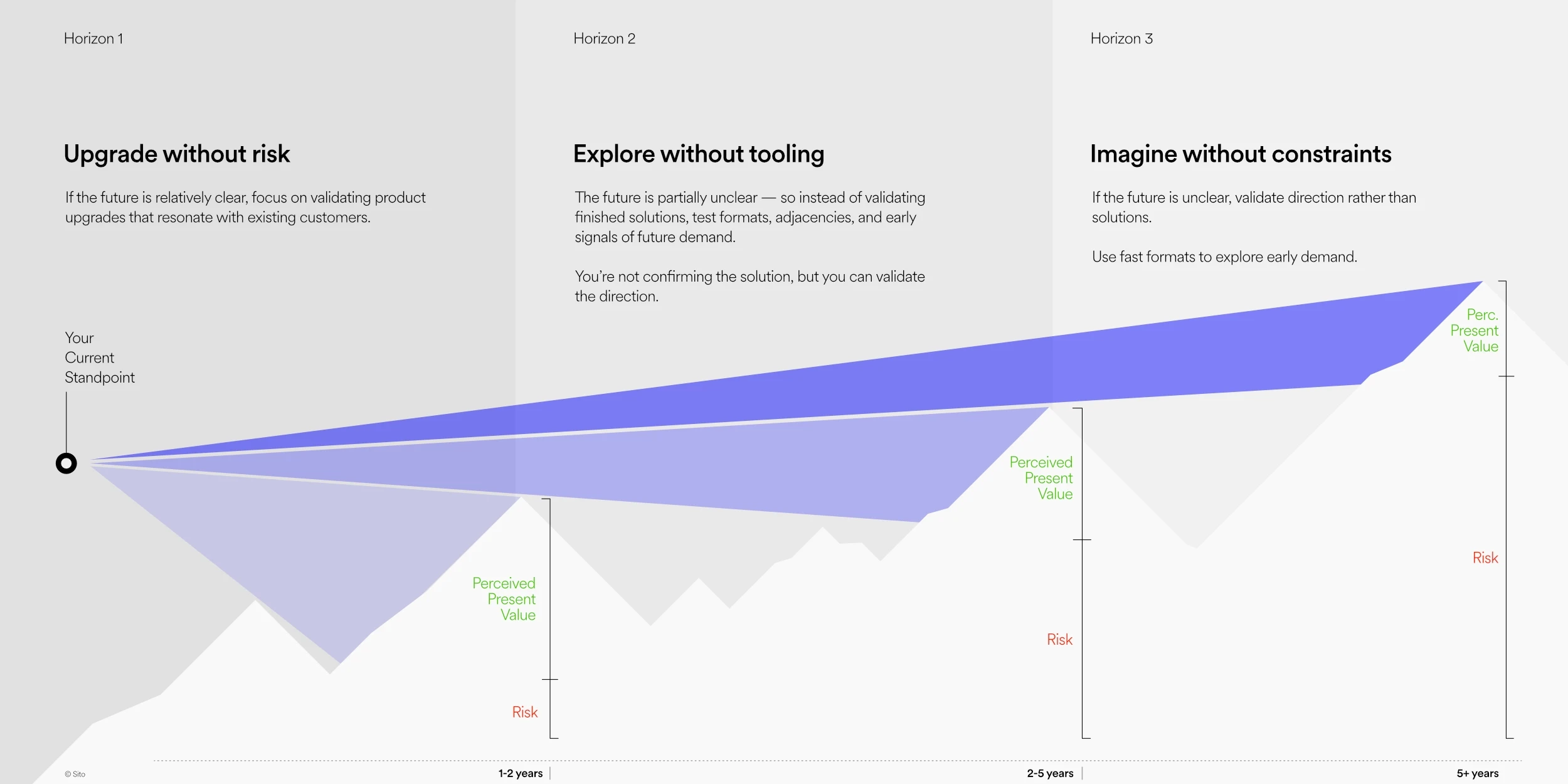By
Luka Stepan
, ON
12 Jun 2025
How Horizon Thinking Can Future-Proof High-Ticket Leisure Products
In the leisure mobility industry, most product strategies revolve around Horizon 1 — what sells now, what launches next, what can be incrementally improved. This focus feels safe. But over time, it breeds stagnation, commoditisation, and margin erosion. The real challenge isn’t generating ideas. It’s knowing which ones to act on now, which ones to nurture, and which to challenge entirely. In other words, it’s a horizon problem.

A Strategic Lens for Product Portfolios
The Three Horizons framework helps balance short-term stability with long-term growth. At Sito, we use it to structure your development efforts — ensuring the near, mid, and long term are all addressed.
Too often, we see product portfolios dominated by near-term sales focus (1–2 years), slowly eating away at differentiation and future margins. This model gives you a working lens for what to strengthen, extend, and rethink completely.
This approach is especially critical in high-ticket, high-complexity industries like caravanning and nautical. The cost of irrelevance is high, but the perceived risk of exploring new ground is even higher. Horizon clarity helps us de-risk that future.
Horizon 1 – Defend the present
This is your present-day revenue engine. The goal here is refinement — to make what you already produce easier to manufacture, easier to sell, and easier to own.
Rework layouts based on actual user behaviour and service data.
Improve perceived quality through finishes, lighting, or detail, without increasing BOM.
Sharpen how your product is positioned and presented in the market.
This is where most teams feel confident. But relying too heavily on H1 creates a false sense of momentum. In caravanning and nautical sectors, supply chain complexity and long development cycles are often cited as excuses — but they shouldn’t be. With the right lens, even incremental updates can serve a broader strategy.
This should account for around 70% of your R&D expenditure.

Horizon 2 – Fund the future
H2 focuses on expanding your current product architecture. You introduce variations that serve new segments or use cases, without betting what you cannot afford.
Prototype for emerging user profiles: younger buyers, digital nomads, EV-compatible users.
Trial new features using low-commitment prototyping methods.
Add configurations or modular options within existing footprints.
This is where future turnover begins. It rarely feels urgent — and that’s the trap. You may be building your next revenue layer here, but it often loses if it competes for attention with H1. The goal is to build this space into your planning and resource allocation consciously.
H2 items funnel into the current product team. Use around 20% of total R&D investment.

Horizon 3 – Insure against irrelevance
H3 is where transformation begins. It’s not just about tech, but about new usage contexts, ownership models, and emerging expectations.
Explore new living and travel patterns your current product ignores.
Rethink ownership: what if the future is subscription, rental, or shared?
Break from conventional archetypes to imagine what comes next.
This is often the least funded — but potentially the most valuable — space. Your challenge isn’t feasibility, it’s imagination and strategic patience.
What we do with you here is visualise and prototype alternative futures, cost-effectively and quickly, so you can validate demand today. That’s how we shrink uncertainty and give you the confidence to back bold ideas.
H3 efforts are best handled by an exploratory squad, typically 10% of your total R&D investment.
Knowing When to Shift
Balancing these horizons is not a strategic concept — it’s an operational reality. The hard part isn’t recognising the horizons. It’s knowing when to lean into each. Getting the timing wrong leads to drift or stall.
Growth in our industries doesn’t come from shinier finishes or louder launches. It comes from horizon clarity — and the ability to break large risks into manageable chunks. That’s how you earn the right to pursue future opportunities.
Use this model to:
Justify balanced investment portfolios across timeframes.
Create internal alignment between design, R&D, and commercial teams.
Defend H2/H3 initiatives to leadership focused on short-term revenue.
This article is the first in a series, addressing long-term product competitiveness in the caravanning and nautical space.
In the next post, we’ll dive into how we systematically de-risk future-focused initiatives in Horizon 2 and 3.
—
Further reading:
Baghai, Mehrdad, Stephen Coley, & David White. The Alchemy of Growth. New York: Perseus, 1999.
Curry, Andrew, Hodgson, Andrew. Seeing in Multiple Horizons: Connecting Futures to Strategy. Journal of Futures Studies, 2008.
Want more insights like this? Connect with Sito on LinkedIn or subscribe to our newsletter.